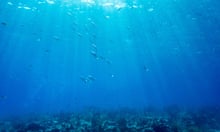As the World Cup approaches, Qatar is going to need at least 10,000 litres of water every day for each of its stadium pitches. Based in a region with virtually no access to fresh water, it is going to rely on desalination – the practice of debrining saltwater so it is drinkable.
It seems like an elegant solution – but the problem is that desalination, which is projected to boom by 37% across the Gulf region in the next five years, has huge environmental costs, in terms of the fossils fuels used to carry out the process, and the marine environment. But without it, how can the arid region possibly quench its thirst?
Forty-three per cent of the world’s desalination capacity comes from Gulf Cooperation Council (GCC) countries. Despite the scarcity of water, the GCC are among the highest consumers of it in the world, and heavily dependent on desalination plants.
The United Arab Emirates has one of the highest per capita water consumption rates in the world, with people using roughly 500 litres a day – 50% above the global average.
Yet many GCC countries such as the UAE are still keen to promote water-rich lifestyles through desalination efforts. Manicured lawns and waterparks are commonplace across cities, and at the Dubai fountain show, every half hour throughout the day more than 83,000 litres of water shoot up as high as a 50-storey building.
But with populations rising, the region’s water industry is facing increasing pressure. “These plants essentially have rivers running through them. If you look at the desalination capacity across the GCC as a whole, the volume of water flowing through that is about four times the amount of water flowing down the Thames,” says Will Le Quesne, the Middle East programme director for the UK Centre for Environment, Fisheries and Aquaculture Science.
Maryam Rashed Al Shehhi, an assistant professor of civil infrastructure and environmental engineering at Khalifa University in the UAE, says: “Desalination is our main source of fresh water. It’s a very arid region, and annual rainfall has decreased. So it’s very scary to think about any other sources of water.”
Since the 1950s the GCC have been at the vanguard of desalination. The southern coasts of the Gulf are dotted with more than 300 desalination plants – mostly in Saudi Arabia, the UAE, Kuwait and Bahrain.

Powering the world’s greatest concentration of desalination requires a significant amount of energy. Saudi Arabia, the largest producer, makes up a fifth of the world’s output, with roughly 30 desalination plants burning through 300,000 barrels of crude oil a day.
In fact, most desalination plants are oil or gas powered, operating with either thermal processing technology, which collects steam from boiling water and condenses it, or the more modern reverse osmosis technology, which relies heavily on electricity produced using natural gas to power pumps that force water through very fine membranes, essentially straining out the salts in the water.
“Either way, you need quite a lot of energy. That can be derived from a lot of sources including by burning fossil fuels,” says Le Quesne.
So although Qatar maintains the World Cup will be carbon-neutral, climate organisations are already expressing doubts. The water demands alone are eye-watering. The tournament will need to manage pitches across eight stadiums, and more than 130 additional training grounds. The delicate and complicated process of creating the right turf for football in the Qatar climate just as the weather begins to cool means the groundsmen have to mimic winter, expert Haitham Al Shareef told Reuters, blowing chilled air over the grass and watering the pitch with at least 10,000 litres of desalinated water.
And for emergencies, “a 425,000 sq metre reserve of grass – some 40 soccer pitches worth – is growing at a farm north of Doha”. The water consumption of that patch is not recorded.
And despite national commitments to reducing carbon emissions and meeting net zero targets, the region is expecting to do more desalination, not less, with capacity planned to expand 37% by 2027.
This could be devastating for the Gulf’s marine ecosystem, says Le Quesne. Desalination is one of the worst marine pollution drivers around the world, producing brine, a highly saline waste fluid usually released into the sea as saltier, toxic and warmer seawater. It can contain chemicals such as chlorine, heavy metals, and anti-foaming agents that are added during the desalination process, which can harm coral reefs and smaller marine organisms that live on the seabed.
Along with water, smaller organisms also risk getting sucked into the system and can get impinged, crashing into the screens of the intake pipes, or entrained, travelling with water reaching the plant, resulting in severe injury and death.
after newsletter promotion

“The microscopic plants of the sea, things like fish eggs, will all get drawn into the system and experience very high levels of mortality. Most of them are typically destroyed on their way through the system,” says Le Quesne.
With growing environmental concerns, GCC countries including the UAE and Oman are exploring methods involving solar energy.
By far the most ambitious plan is Saudi Arabia’s solar dome, the world’s first zero-brine discharge desalination plant. Announced in 2020, the project is now being prototyped as part of Neom, the outlandish $500bn (£447bn) planned megacity.
Partnering with a London-based company, Solar Water, the 20-metre high dome made from glass and steel is proposed to be surrounded by mirrors that will collect sunlight to heat up the seawater, condense it in a separate chamber, and distill it into fresh water.
“The dome itself will be illuminated by this strong sunlight. It’ll look like a sparkling jewel in the desert,” says Christopher Sansom, a professor of concentrating solar power at the University of Derby and a director at Solar Water.
But although the solar dome will, the designers say, be cheaper to build and operate than conventional plants, it will also produce significantly less water.
Though Saudi Arabia has no shortage of sunlight, solar-powered desalination can have its limitations, says Sansom. Any interference with clouds or wind can stop the power from being generated. Dust is another factor that can hinder the technology. In a desert environment such as Saudi Arabia, solar panels need to be wiped clean.
While promising, Al Shehhi says desalination plants running completely with solar energy is not yet practical and more research is needed into implementing more renewable energy into the desalination process.
“It’s a challenge. The amount of water pumped every day from the Gulf to be desalinated is huge,” she says. And that is before a World Cup is added into the equation.










